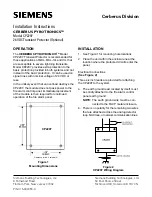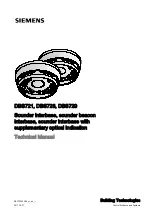
Matsushita Electric Works Fire & Security Technology AB
MEW00442
Rev: -
Operating Instructions EBL512, V1.44.x
6
2
Definitions / Explanations
Definitions / explanations / abbreviations / etc. frequently used or not
explained elsewhere in the document.
2.1 MFSTech
M
atsushita Electric Works
F
ire &
S
ecurity
Tech
nology AB
2.2 Alarm
points
Units, which can generate fire alarm (in the control unit), i.e. a sensor,
a conventional detector, a manual call point, etc.
2.2.1 Smoke
detector
Two types of analog and conventional smoke detectors are available:
photo electric (optical) and ionization.
2.2.2 Sensor
Sensor = Analog detector
2.2.3 Analog
detector
Contains an A/D-converter. The
C
ontrol
U
nit pick up the digital
values ("sensor values") for each detector individually. All
evaluations and "decisions" are then made in the C.U. Analog
detectors are addressable – an address setting tool is used for detector
types
3
xxx and a DIL-switch in the
ASB
(see below)for detectors
2
xxx. An analog detector has to be plugged in an ASB.
2.2.4
(Analog) Sensor Base (ASB)
A sensor is plugged in an ASB, which is connected to a COM loop
(see below). Sensor Base types
2
xxx have a DIL-switch for COM
loop address setting.
2.2.5 Conventional
detector
Detector with two states, normal or fire alarm. The detector contains a
closing contact and a series alarm resistor. Some types are plugged in
an
ADB
(see below) or a
CDB
(see below). Some types are also
available as addressable, to be connected to a COM loop (see below).
(Normally plugged in a
CDB
(see below), connected to a conventional
zone line with end-of-line resistor.)
2.2.6 Conventional
Detector Base (CDB)
A conventional detector is plugged in a CDB, connected to an external
line, an addressable zone interface, conventional zone line, etc.
2.2.7 Addressable
Detector Base (ADB)
A conventional detector is plugged in an ADB, connected to a COM
loop (see below).



































